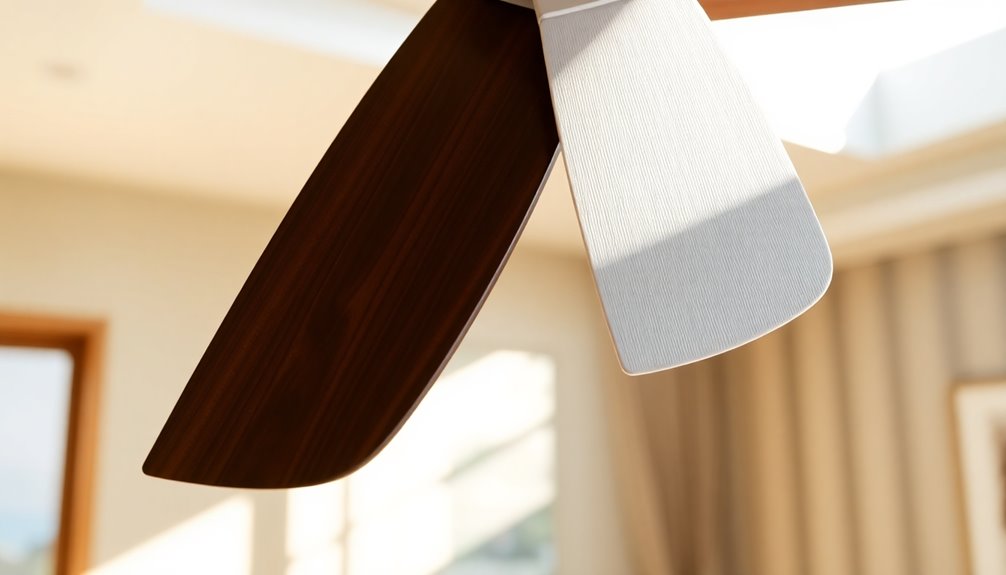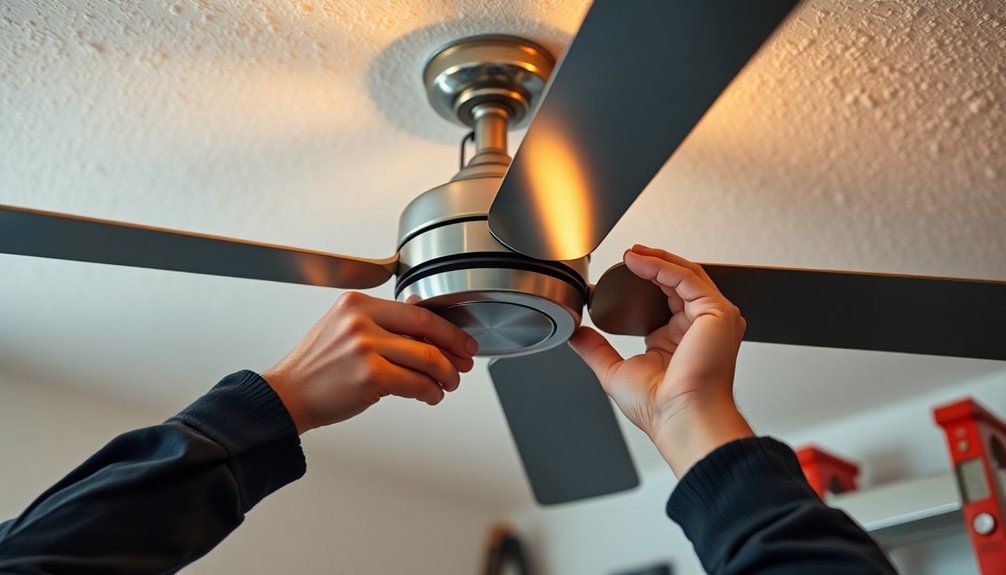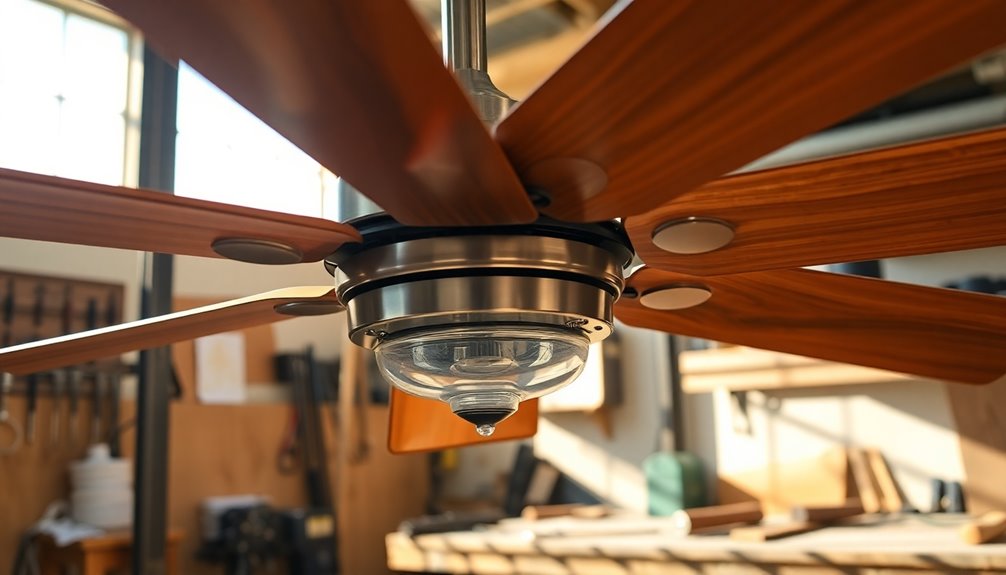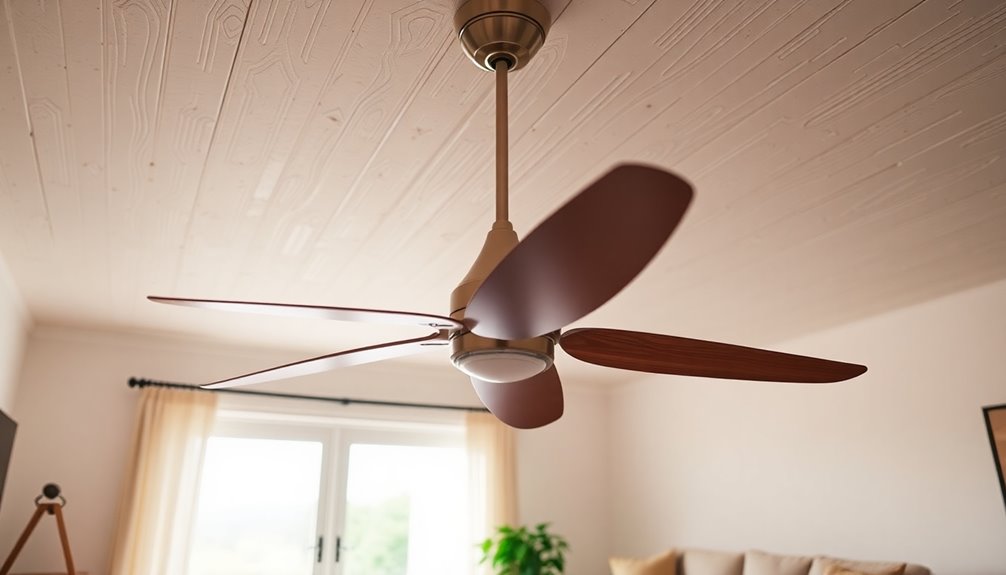Ceiling fan blades aren't universally interchangeable. Their compatibility depends on the specific model and manufacturer, so you'll need to check your fan's details. Measure the existing blades to ascertain the new ones match in length and weight, and inspect the attachment points as well. Remember that materials and designs vary, so select blades that fit your fan type—indoor or outdoor—properly. If you want to keep your fan running smoothly, maintaining compatibility is essential. There's plenty more to explore on how to find the right blades and guarantee peak performance for your ceiling fan.
Key Takeaways
- Ceiling fan blades are not universally interchangeable; compatibility varies by model and manufacturer specifications.
- Accurate measurement of existing blades is crucial for ensuring a proper fit and performance.
- Check the mounting type, length, and weight specifications outlined in the fan's owner's manual.
- Some brands offer custom blade sets designed for enhanced compatibility with specific fan models.
- Indoor and outdoor blades differ in materials and weather resistance; ensure proper usage based on the intended environment.
Understanding Blade Compatibility

When considering new blades for your ceiling fan, it's essential to understand that they're not universally interchangeable. Blade compatibility depends on the specific model and manufacturer of your fan. To guarantee peak performance, replacement ceiling fan blades must match the mounting type, length, and weight specifications outlined in your fan's owner's manual.
You'll want to verify the blade dimensions against your original blades to maintain proper balance and airflow efficiency. If you don't, you could end up with a fan that wobbles or doesn't circulate air effectively. Some brands, like Fanimation and Craftmade, offer custom blade sets specifically designed for their fan models, enhancing compatibility and performance.
Additionally, if you're installing a fan outdoors, remember that outdoor-rated blades differ from indoor blades. These must be chosen based on their weather resistance and durability requirements.
By paying attention to these details, you'll guarantee that your replacement ceiling fan blades fit your fan perfectly and operate effectively, creating a comfortable environment in your space.
Factors Affecting Interchangeability

Choosing the right replacement blades for your ceiling fan can be tricky, as several factors impact their interchangeability. First, you need to take into account the specific model of your fan. Ceiling fan replacement blades aren't universally compatible; they must match the original blade size to avoid stressing the fan motor and diminishing efficiency.
Next, look at the mounting system. Different brands and models often have unique attachment points, so verifying the mounting type is essential before you purchase any new blades. If the blades aren't designed for your fan's specific style, they mightn't fit properly, leading to performance issues.
Material and design also play significant roles in airflow and overall performance. Choosing blades made for the same fan type guarantees peak functionality and efficiency.
Finally, always refer to your fan's owner's manual or the manufacturer's guidelines. They provide vital information about suitable ceiling fan replacement blades tailored to your fan's motor and housing.
Taking these factors into account will help you make an informed decision and keep your ceiling fan running smoothly.
Identifying Your Ceiling Fan Model

To guarantee you get the right replacement blades for your ceiling fan, identifying your fan model is essential. Most fans require specific blade sizes and mounting types, so knowing your model helps ascertain compatibility.
Start by checking the original packaging, manual, or warranty documentation for the model number and specifications related to blade replacements.
If you can't find the original packaging, don't worry. Inspect the fan's motor housing or base for a label or engraving that may provide the necessary model information. This can be especially helpful if you have a popular brand like Hampton Bay or Craftmade, as they often have distinct model lines.
Once you have your model number, you can utilize online resources or manufacturer websites to locate compatible replacement blades. These platforms usually offer valuable information based on dimensions and design, making your search much easier.
Measuring Blade Dimensions

Measuring the dimensions of your ceiling fan blades is vital for finding the right replacements. To guarantee a proper fit, you need to accurately measure your existing blades. Follow these steps to get the dimensions you need:
- Measure the length of the blades from tip to tip, typically ranging from 21 inches to over 60 inches.
- Check the width and shape of the blades, as these factors can affect airflow and performance.
- Inspect the attachment points on the fan motor and housing to confirm compatibility with new blades.
When measuring blade dimensions, remember that replacement blades should match the size of the original ones. This is important to avoid stressing the motor and guarantee peak fan performance.
You can often find the blade dimensions in your fan's manual, warranty, or on the box. Taking these measurements carefully will help you select compatible replacements that fit seamlessly into your ceiling fan setup.
With the right dimensions in hand, you'll be set to enhance your fan's efficiency and style without any hassle.
Types of Replacement Blades

When it comes to selecting replacement ceiling fan blades, you'll find a diverse array of options that cater to both aesthetic preferences and functional requirements. Replacement fan blades come in various materials, including wood, plastic, metal, and bamboo, each offering unique benefits. Sizes range from 21 inches to over 60 inches, so it's essential to match the blade size to your specific fan model for proper performance.
Here's a quick overview of the types of replacement blades available:
| Type | Description |
|---|---|
| Standard Blades | Typically made of wood or plastic, versatile for any room. |
| Outdoor Blades | Weather-resistant materials designed for durability. |
| Specialty Blades | Unique shapes like tropical palm fronds, perfect for themed décor. |
Always check for compatibility with specific fan models, as not all blades are interchangeable. Consult your fan's owner's manual for recommended blades to guarantee a perfect fit and peak performance. With the right replacement fan blades, you can enhance both the look and efficiency of your ceiling fan.
Installation Considerations

When you're installing new ceiling fan blades, it's essential to guarantee they're compatible with your existing fan.
Make sure to check the mounting type and blade length to avoid any issues during installation.
Proper installation techniques will help maintain your fan's performance and prevent potential damage.
Compatibility With Existing Fans
Verifying compatibility with your existing ceiling fan is crucial before replacing its blades. Ceiling fan blades aren't universally interchangeable; they need to match your specific model and brand. This guarantees proper fit and performance, avoiding any potential problems.
When considering replacement blades, keep these factors in mind:
- Blade Length: Choose blades that match the original size for maximum airflow.
- Mounting Type: Confirm the mounting style is the same to prevent stress on the motor.
- Manufacturer Specifications: Always consult your fan's manual to confirm compatibility.
Installing incompatible blades can lead to issues like wobbling, reduced airflow efficiency, or increased wear on the motor.
Some manufacturers even offer custom blade sets specifically designed for their fans, enhancing the likelihood of achieving a proper fit.
By prioritizing compatibility, you'll not only improve the fan's performance but also prolong its lifespan.
Proper Installation Techniques
After confirming that the replacement blades are compatible with your ceiling fan, it's time to focus on installation.
Start by making sure you have a step stool or ladder handy to safely access the fan. Don't forget to wear safety goggles to protect your eyes from dust and debris while you work.
Carefully remove the screws securing the old blades, storing them safely for when you install the new ones. Measure the removed blades to confirm the size of your replacements.
When you begin replacing ceiling fan blades, install them one at a time. Tighten each screw securely to prevent any wobbling and make sure the blades are aligned correctly before powering up the fan.
Once you've finished, conduct a final inspection. Check for stability and watch for any unusual movement during operation. If you notice anything off, adjust the screws as necessary to maintain proper function. Additionally, ensuring that you choose blades designed for optimal air circulation will enhance your fan's performance.
Using these proper installation techniques will make certain your ceiling fan operates smoothly and efficiently, giving you peace of mind and a rejuvenating breeze in your space.
Outdoor vs. Indoor Blades

When choosing ceiling fan blades, you need to take into account the material durability and weather resistance of each type.
Outdoor blades are crafted from robust materials designed to handle moisture and harsh conditions, while indoor blades might deteriorate if exposed to the elements.
Always check the specifications to verify you're using the right blades for your environment.
Material Durability Differences
Choosing the right ceiling fan blades is essential, especially when considering the material durability differences between outdoor and indoor options.
Outdoor ceiling fan blades are specifically designed to withstand harsh conditions, while indoor blades lack these protective features.
Here's a quick comparison to help you visualize:
- Outdoor blades: Often made from weather-resistant materials like plastic or treated wood, guaranteeing they can handle moisture and debris.
- Durability: Outdoor-rated blades endure direct sunlight, rain, and temperature fluctuations without fading or corroding.
- Maintenance: Outdoor blades require regular cleaning to prevent dirt and grime buildup, while indoor blades generally stay cleaner due to their sheltered environment.
If you're thinking about a Replacement Fan, remember that using outdoor blades indoors is usually fine, but the reverse can lead to rapid wear and safety hazards.
Moisture can wreak havoc on indoor blades designed for protected spaces.
Weather Resistance Requirements
Understanding the weather resistance requirements for ceiling fan blades can greatly impact their performance and longevity in different environments. Choosing the right fan blades is essential, especially when considering indoor versus outdoor applications. Indoor ceiling fan blades aren't designed to handle moisture or humidity, which makes them unsuitable for outdoor use.
Here's a quick overview of blade ratings:
| Blade Type | Weather Resistance |
|---|---|
| Indoor | Not moisture-resistant |
| Damp-rated | For moisture-prone areas |
| Wet-rated | Designed for direct water exposure |
| Outdoor | Made from weather-resistant materials |
| Indoor Ceiling Fan Blades | Not suitable for outdoor use |
Outdoor-rated fan blades are specifically constructed from weather-resistant materials, guaranteeing they can endure rain and UV rays without damage. If you're considering installing a fan in a moisture-prone area like a bathroom, damp-rated blades may suffice. However, for direct exposure to water, opt for wet-rated blades. Always check the manufacturer's specifications to verify you're using the appropriate blade type for your intended environment.
Troubleshooting Compatibility Issues

Troubleshooting compatibility issues with ceiling fan blades starts with verifying you have the right match for your specific fan model. To do this effectively, check to make sure you're considering the following factors:
- Mounting type: Different fans require specific blade types for proper installation.
- Attachment points: Confirm that the blades' attachment points align with your fan's motor and housing.
- Weight distribution: Different materials can affect how the fan operates and its longevity.
If you don't match the blades correctly, you might experience wobbling, reduced airflow, or even damage to the fan motor.
Always refer to the owner's manual or manufacturer guidelines to find compatible blade options for your fan. Remember, not all blades come designed for every fan.
If you're uncertain, it's better to consult a professional or reach out to the manufacturer for assistance.
Maintaining Fan Performance

To keep your ceiling fan running smoothly, you need to verify blade compatibility and perform regular maintenance. Check for wear and tear on the blades, and don't forget to clean them to maximize airflow. Following these steps will help you maintain peak performance and extend your fan's lifespan. Additionally, understanding heat pump efficiency can provide insights into optimizing energy use across various home appliances, including ceiling fans.
Importance of Blade Compatibility
Often overlooked, the compatibility of ceiling fan blades plays an important role in maintaining ideal fan performance. When you need to replace your fan blades, verify they match your fan's specific mounting type and size. Using incompatible blades can lead to issues that detract from your fan's efficiency.
Consider these crucial points about blade compatibility:
- Weight Matters: Blades that are too heavy or light can strain the motor.
- Size Counts: Always opt for blades the same size as the existing ones; larger blades won't greatly boost airflow.
- Design Specificity: Some fans only work with certain blade materials or designs.
Regular Maintenance Practices
Regular maintenance practices are crucial for keeping your ceiling fan running smoothly and effectively. Start by regularly cleaning the blades to prevent dust buildup, which can hinder performance and cause irritation while the fan operates.
Inspect the blades for any signs of wear or damage; if they're worn, it's time to replace them. Damaged blades can decrease airflow efficiency, leading to increased energy costs.
Next, periodically tighten the screws and check the blade alignment. This helps guarantee stable operation and prevents wobbling, which can strain the motor.
Additionally, lubricate the fan motor and check for any loose components to prolong the lifespan of your fan and maintain peak performance.
If you notice a drop in performance or if the blades are damaged, don't hesitate to replace them. New blades can greatly enhance airflow and refresh the fan's aesthetics. Regular maintenance also helps ensure effective filtration of airborne pollutants, contributing to improved indoor air quality.
Where to Find Replacement Blades

Finding the right replacement blades for your ceiling fan can be a straightforward process if you know where to look. Start by checking local home improvement stores like Home Depot, where you'll likely find a selection of replacement blades suitable for various fan models. You can even use their mobile app to confirm product availability.
If you're looking for something specific, consider these options:
- Online marketplaces: Sites like Amazon and eBay often have a wide variety of replacement blades. Just make sure to verify compatibility with your fan model before making a purchase.
- Specialized websites: For specific brands like Hampton Bay, check out eceilingfans.com for a more tailored selection of parts.
- Manufacturer resources: Some manufacturers offer custom replacement blades that perfectly match your fan's style and dimensions.
If your searches yield no results, don't hesitate to contact the fan manufacturer directly. They can guide you in sourcing the correct replacement blades, ensuring your ceiling fan remains functional and stylish.
Frequently Asked Questions
Can You Switch Blades on a Ceiling Fan?
Yes, you can switch blades on a ceiling fan, but it's vital to verify they match the size and mounting type of your current fan.
Check the manufacturer's specifications to confirm compatibility with the motor and housing.
While you can mix blades from different fans, sticking to the same size is best for performance and airflow.
If you're unsure, consult the owner's manual or reach out to the manufacturer for guidance.
Are All Ceiling Fan Blades the Same?
Imagine trying to fit a square peg into a round hole; that's like using mismatched ceiling fan blades.
Not all blades are the same. They come in different sizes, shapes, and materials, and using the wrong ones can lead to problems.
You need to match the replacement blades with your fan's specifications to guarantee it works properly.
Always check your fan's manual or consult the manufacturer before making a purchase for the best results.
How to Find the Right Fan Blade Replacement?
To find the right fan blade replacement, start by measuring the length of your existing blades.
You'll want to check your fan's manual or packaging for specific dimensions and compatibility requirements.
It's essential to match the size to prevent motor stress and guarantee good airflow.
Also, consider the material and design that fits your style and the intended use of the fan, whether it's for indoors or outdoors.
Do All Ceiling Fans Fit the Same?
When it comes to ceiling fans, not all of 'em fit the same. Each model has its unique design and specifications, making compatibility a tricky game.
If you're looking to replace or install a fan, check the manufacturer's guidelines closely. You'll want to guarantee that the mounting type and size match up.
Skipping this step could lead to safety issues and operational problems down the line. So, don't cut corners!
Conclusion
In the world of ceiling fans, "Don't judge a book by its cover" rings true—interchanging blades can enhance both function and style. By understanding compatibility and measuring dimensions, you can find the perfect replacement blades for your fan. Whether you're sprucing up your indoor space or tackling outdoor needs, knowing where to shop and how to troubleshoot can keep your fan running smoothly. So, go ahead and give your ceiling fan a fresh new look!









